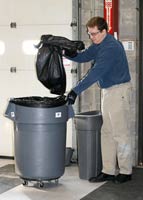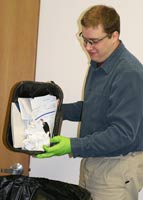
Training, Supervision Prevent Blood Exposures
BBP Case Study: Vonachen Services Inc.
- By Jerry Laws
- Mar 14, 2008
"Usually the sharps are in the appropriate container, but you can never be sure. All of our janitorial staff has to be aware of the potential risk."
--Safety & Risk Management Director & Employee Relations Manager Vicky Leinweber, Vonachen Services Inc.
 Hands-on supervision and a strong training program are the backbone of the BBP program at Vonachen Services Inc. (VSI), a janitorial services contracting company based in Peoria, Ill. About 125 of its approximately 880 employees work in health care facilities, and another 510 employees have some risk of BBP exposure, Safety & Risk Management Director & Employee Relations Manager Vicky Leinweber said in a recent interview. The company serves customers in Iowa, Illinois, and Mississippi.
Hands-on supervision and a strong training program are the backbone of the BBP program at Vonachen Services Inc. (VSI), a janitorial services contracting company based in Peoria, Ill. About 125 of its approximately 880 employees work in health care facilities, and another 510 employees have some risk of BBP exposure, Safety & Risk Management Director & Employee Relations Manager Vicky Leinweber said in a recent interview. The company serves customers in Iowa, Illinois, and Mississippi.
Initial awareness training is delivered before new employees are allowed to go to their new work locations, and those who will be working in medical facilities such as clinics are offered hepatitis B vaccinations at company expense during the initial training. Vonachen Services allows only a small percentage of its workers to clean up potentially infectious materials; supervisors are called, and they perform the cleanup or call a properly trained employee to do it. Supervisors also ensure that workers use appropriate PPE and follow company guidelines for cleanups, incident reporting, and removing and disposing of gloves and protective suits. All employees receive a BBP review every January during safety meetings that are tracked, documented, and reviewed by the company's executive staff.
"It is a common thing for a normal person to push trash down with your hand. I do this all the time in my kitchen without thinking," Leinweber said. "This habit tends to carry over to the workplace for our janitorial staff, so they have to be trained not to do this because of the possibility of a sharp or unknown object that was mistakenly thrown in the wrong container."
"For our employees who work in a health care facility, they routinely encounter sharps, blood, urine, and used medical materials that have been thrown into the trash. Usually the sharps are in the appropriate container, but you can never be sure. All of our janitorial staff has to be aware of the potential risk," Leinweber said.
BBP exposures are reported immediately to the employee's supervisor and then to Leinweber. Immediate medical treatment follows if necessary. She said only two needlesticks involving VSI employees have occurred during the past six years--and one of these involved a worker who was stuck by a used needle while emptying an ordinary trash receptacle in a factory, where sharps wouldn't be expected. Though traumatized, the worker wasn't harmed, she said. (The customer and VSI investigated and concluded a diabetic had discarded the needle after self-administering an injection, Leinweber said.)
Congratulated on the company's good record, she said, "I'd say it's more than luck, because we do put a high importance on this program. You want everyone trained, because if someone cuts their hand and they rush to the rescue, you've got a potential there of infectious materials. The natural thing is to want to help your co-worker. . . . Whether or not they're in medical care where the sharps are of more concern, you've always got the exposure of someone being injured and you wanting to help."
VSI implemented a "three strikes" disciplinary policy about four years ago. "With the first unsafe behavior, you get a final written warning," Leinweber explained. "The second is days off, and the third, you're out of here, whether or not there's an accident or injury or property damage associated with it. Now, the trick is getting everybody to get on board with it when there's not property damage or injury involved. It's getting the supervisors to recognize, 'Hey, this is an unsafe behavior, I need to address it before something happens.' That's had a real impact on our safety program, as well."
Committed employees and experienced supervisors are all-important to keeping the program on track, she said. "Our supervisors are very well trained. They're committed to it as much as I am," Leinweber said. "They pretty much stay in place; we have very little turnover in the supervisor ranks.
"We have so many good employees that have been with us for years and years. And it's amazing to me that they're so proud of their work of getting something clean and making it acceptable, presentable, to the customer. . . . They probably don't get patted on the back enough," said Leinweber. "They should. They have a job that really goes unrecognized by most."
ISSA/OSHA Alliance Promotes Cleaners' Safety
Bloodborne pathogens safety is part of OSHA's current alliance with ISSA, a large organization of companies involved in the worldwide cleaning and building maintenance business. Besides its section on BBP, there are sections about personal protective equipment, recordkeeping, slips and falls, and cleaning chemicals/Hazard Communication at ISSA's Safety and Health Portal, which is done in conjunction with OSHA as part of the alliance.
ISSA's Cleaning Industry Management Standard (CIMS) is a consensus standard to which facility service organizations can become certified through a comprehensive assessment by an ISSA-accredited third party assessor. (Vonachen Services Inc. has been certified to CIMS. A list of certified organizations is available at www.issa.com.) CIMS includes adherence to BBP good practices in its Section 4, the section covering safety of the working environment, said Daniel Wagner, ISSA's director of CIMS.
The ISSA/OSHA alliance promotes the safety and health of workers in the cleaning industry. Representatives of both organizations signed the alliance agreement on Aug. 5, 2005, and renewed it on Aug. 16, 2007. For details, visit www.osha.gov/dcsp/alliances/issa/issa.html.
Studies Show High Cost of Needlesticks
Surveys and field reports indicate OSHA's BBP standard and also safe needle laws passed at the state level have reduced needlestick-related infections significantly among U.S. health care workers. But recent studies also suggest non-hospital-based nurses continue to be exposed at relatively high rates and report needle injuries infrequently, and the overall cost of needlestick injuries and subsequent infections is high.
J. Paul Leigh of the University of California, Davis' Center for Healthcare Policy and Research and colleagues sought to estimate the cost of needlestick injuries in a study that was published in September 2007 in Current Medical Research and Opinion (Vol. 23, No. 9, pp. 2093-2105). They estimated there were 644,963 needlesticks among hospital-based and non-hospital-based workers in the U.S. health care industry in 2004. While only 49 percent of these cases resulted in costs, medical costs were $107.3 million (divided into 96 percent for testing and prophylaxis and 4 percent for treating long-term infections--34 people with chronic HBV, 143 with chronic HCV, and one with HIV). They estimated lost-work productivity's cost at $81.2 million. Combined, the medical and productivity costs totaled $188.5 million, they concluded, estimating that the costs probably ranged from $100.7 million to $405.9 million.
Using a phone survey, two NIOSH researchers interviewed 593 workers who had been treated in emergency departments in 2000-2002 for potential work-related exposures to bloodborne pathogens. They found 382 of these people were from hospitals, 51 were from emergency medical services or firefighting, 86 were from non-hospital health care settings, 22 were from law enforcement (including police and correctional facilities), and 52 were from other non-health care settings such as schools and restaurants. Needlestick injuries were the primary source of exposure in hospitals and non-hospital health care settings alike. Writing in the April 2007 issue of the American Journal of Industrial Medicine, they concluded workers from non-hospital settings were less likely than were hospital workers to use PPE, have BBP safety training, be aware of BBP standards and exposure treatment procedures, and report or seek treatment for a work-related exposure. Both groups have unique needs that should be addressed, they wrote. ("Potential work-related exposures to bloodborne pathogens by industry and occupation in the United States Part II: A telephone interview study," Guang X. Chen, M.D., MSc, E. Lynn Jenkins, Ph.D., April 2007, Vol. 50, Issue 4 , pp. 285-292, Wiley-Liss, Inc.)
Similarly, Robyn R.M. Gershon of Columbia University's Mailman School of Public Health and colleagues estimated a percutaneous injury rate of 13.8 per 100 person years among non-hospital-based registered nurses working in New York State in a 12-month period. The study population was 1,156 RNs, mainly unionized public sector workers in state institutions, who might be expected to report their needlestick injuries more readily than RNs in private practice, but Gershon, et al. found 49 percent of percutaneous injuries were never reported by members of this study population, and 70 percent of those who suffered injuries never received any post-exposure care. Of those who did receive care, only 20 percent were seen within two hours. Time constraints, fear, and lack of information on how to report an injury were the chief reasons for not reporting, they found. Extrapolating their calculated injury rate, the authors of this paper estimated that more than 145,000 needlesticks occur annually among all U.S. non-hospital-based registered nurses. ("Non-Hospital Based Registered Nurses and the Risk of Bloodborne Pathogen Exposure," Industrial Health, October 2007. Vol. 45, No. 5, pp. 695-704, NIOSH).
These studies show the wide variety of workers who may be occupationally exposed to bloodborne pathogens, including emergency and law enforcement personnel, physicians, nurses, nursing home attendants, home health caregivers, maintenance workers, and janitorial staff.
This article originally appeared in the April 2008 issue of Occupational Health & Safety.